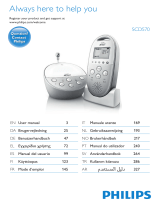Philips is dedicated to producing caring, reliable products to give parents the reassurance they
need.You can trust this Philips baby monitor to provide round-the-clock support by ensuring you
can always hear your baby clearly without any disturbing noise.Your SCD489 uses DECT
technology which guarantees zero interference from other wireless appliances and a clear signal
between the parent unit and baby unit.
Philips Baby Care, taking care together
Safety information
Please read this user manual carefully before using your baby monitor and keep it for future
reference.This baby monitor is intended as an aid. It is not a substitute for responsible and
proper adult supervision and should not be used as such.
• Make sure the baby unit and adapter cable are always out of reach of the baby
(at least 1 meter / 3 feet away).
• Never place the baby unit inside the baby’s bed or playpen.
• Never cover the baby monitor (with a towel, blanket, etc.).
• Never use the baby monitor in moist places or close to water.
• Check if the voltage indicated on the type plate of the adapters (A-14, B-14) corresponds to
the local power voltage before connecting to the AC power supply.
• Do not expose the baby monitor to extreme cold, heat or light (e.g. direct sunlight).
• To prevent electric shock, do not open the case of the baby unit and parent unit
(except battery compartment covers).
• Risk of explosion if batteries are replaced by an incorrect type.
For the parent unit, always use rechargeable batteries.
Baby unit
The baby unit can be mains or battery operated.
When batteries are inserted, you will have an automatic back-up
in case of mains failure.
Mains operated use
1 Connect the power adapter cord (A-14) to the power supply
jack (DC 9V / 300mA - A-13) of the baby unit.
2 Connect the AC power adapter (A-14) to a wall outlet.
➜ The baby unit is now ready for mains operated use!
Welcome
Preparing your baby monitor
7
EN





















